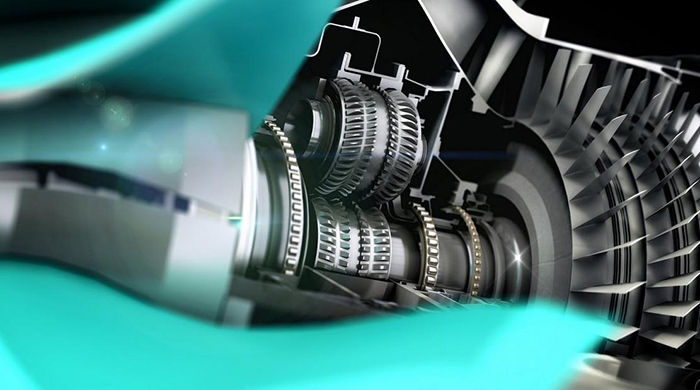Finite Element Method Based Analysis of Planetary Gear Systems Considering Backlash and Manufacturing Deviations
Finite Element Method Based Analysis of Planetary Gear Systems Considering Backlash and Manufacturing Deviations
The load carrying capacity of gear transmissions depends strongly on design, material and operation conditions. Modern analysis methods, e.g. — finite element analysis (FEA) — consider the above parameters with more or less sufficient accuracy. Yet it remains an ongoing challenge to account for backlash and manufacturing errors, despite a definite need to do so. There are in fact several difficulties to overcome; first, the contact footprints as well as backlash and errors are some orders of magnitude smaller than the dimensions of the gears. Therefore an extremely fine mesh is required. On the other hand, the total number of degrees of freedom (DOFs) should be kept as small as possible to keep the computational effort manageable. Less stressed areas should be coarsely meshed, while the transition must be as smooth as possible. Moreover, in order to generate and mesh three-dimensional tooth flanks taking into consideration the abovementioned geometrical deviations is extremely time consuming.
In this paper new techniques and tools are introduced, aiming to facilitate the modelling procedure. They include automatic generation of 3-D gear flanks and selective meshing. A simple planetary gear system featuring helical gears with backlash and manufacturing errors is used to demonstrate the effectiveness of the proposed procedure, since it features multiple contacts and floating members. Results shown include stress distribution and deformation, as well as load sharing under quasi-static conditions.
Planetary gear trains offer very high power density because of their internal power splitting. It is evident that manufacturing deviations have a strong impact on power distribution. Therefore simulations aiming at the prediction of the actual loading of real, non-ideal, planetary systems are very useful. A lot of research has been conducted in this field. Reference 1 contains an extensive literature review. Finite element analysis is, of course, one of the first available methods to be used. It should be considered that an adequate mesh must be generated to capture the influence of inaccuracies. This is quite challenging because of several reasons. For example, the gears themselves are quite complex and the deviations are some orders of magnitude smaller than the overall dimensions of the complete system. In a previous paper (Ref. 1), the influence of backlash and manufacturing errors of carrier and gears of a simple planetary system is demonstrated. Furthermore, the favorable impact of a floating, self-centering sun on the load distribution was shown. However, the model was 2-dimensional; this is an important drawback, as it restricts its application to straight spur gears. The current study advances one step further and introduces a 3-D model that makes possible the analysis of planetary systems consisting of helical gears.
Planetary Gear Train
In the current study a simple planetary gear system with helical gears is modeled (Fig. 1); it consists of a fixed ring gear mounted on the housing, a carrier with three equally spaced planets, and the sun. Two versions are studied; in the first, the sun rotates around a fixed axis or, put in another way, the input shaft is supported by two bearings; in the second version the input torque is transmitted to the sun gear by a double-articulated spline coupling. Therefore it is free to position itself between the planet gears. The planet gears are mounted on the pins by two roller bearings. The carrier is mounted in the housing also by two bearings. Torque output is through the carrier. The carrier and the pins are considered very stiff compared to the gears, and therefore are not included in the model. All gears have the same facewidth and are made from case hardened steel; the gear data are included (Fig. 1).














 Athanassios Mihailidis is Professor and Director of the Laboratory of Machine Elements & Machine Design of the School of Mechanical Engineering of the Aristotle University of Thessaloniki. His research interests include machine elements, gears and power transmission systems, tribology and thermo-elastohydrodynamic lubrication, as well as automotive engineering. Mihailidis is a founding member of the Balkan Tribological Association as well as of the Balkan Association of Power Transmissions.
Athanassios Mihailidis is Professor and Director of the Laboratory of Machine Elements & Machine Design of the School of Mechanical Engineering of the Aristotle University of Thessaloniki. His research interests include machine elements, gears and power transmission systems, tribology and thermo-elastohydrodynamic lubrication, as well as automotive engineering. Mihailidis is a founding member of the Balkan Tribological Association as well as of the Balkan Association of Power Transmissions. George Korbetis studied mechanical engineering at the Aristotle University of Thessaloniki. After working for several years in the machine design field, he joined in 2001 the BETA CAE’s Customer Service Department. Korbetis is responsible for the morphing and optimization applications.
George Korbetis studied mechanical engineering at the Aristotle University of Thessaloniki. After working for several years in the machine design field, he joined in 2001 the BETA CAE’s Customer Service Department. Korbetis is responsible for the morphing and optimization applications. Nikolaos Drivakos, upon graduation from the School of Mechanical Engineering of the Aristotle University of Thessaloniki, worked as a Research Assistant in the Lab. of Machine Elements and Machine Design. He completed his Ph.D. thesis in 2006. Since then, Drivakos is a member of the Customer Service Department of BETA CAE, specializing in CAD input, meshing and assembly of models.
Nikolaos Drivakos, upon graduation from the School of Mechanical Engineering of the Aristotle University of Thessaloniki, worked as a Research Assistant in the Lab. of Machine Elements and Machine Design. He completed his Ph.D. thesis in 2006. Since then, Drivakos is a member of the Customer Service Department of BETA CAE, specializing in CAD input, meshing and assembly of models. Ioannis Nerantzis worked as a research assistant in the Lab. of Machine Elements and Machine Design of the Aristotle University of Thessaloniki. After completing his Ph.D. Thesis in 2012, he became a member of the Customers Service Department of BETA CAE Systems. Nerantzis specializes in durability applications, including support for ABAQUS- related issues.
Ioannis Nerantzis worked as a research assistant in the Lab. of Machine Elements and Machine Design of the Aristotle University of Thessaloniki. After completing his Ph.D. Thesis in 2012, he became a member of the Customers Service Department of BETA CAE Systems. Nerantzis specializes in durability applications, including support for ABAQUS- related issues.